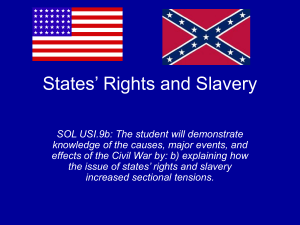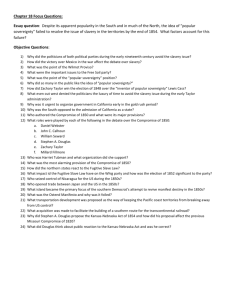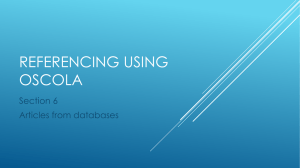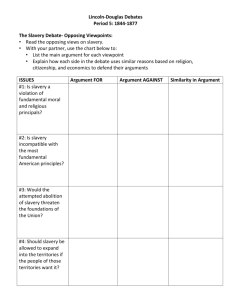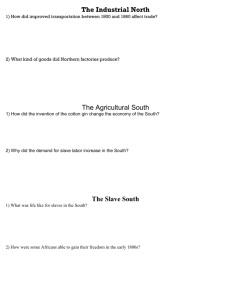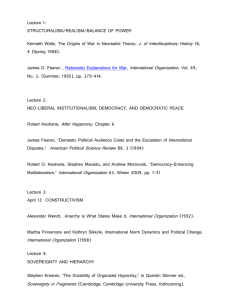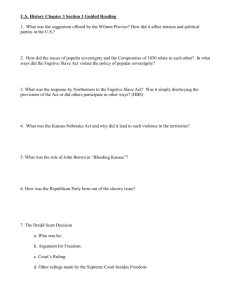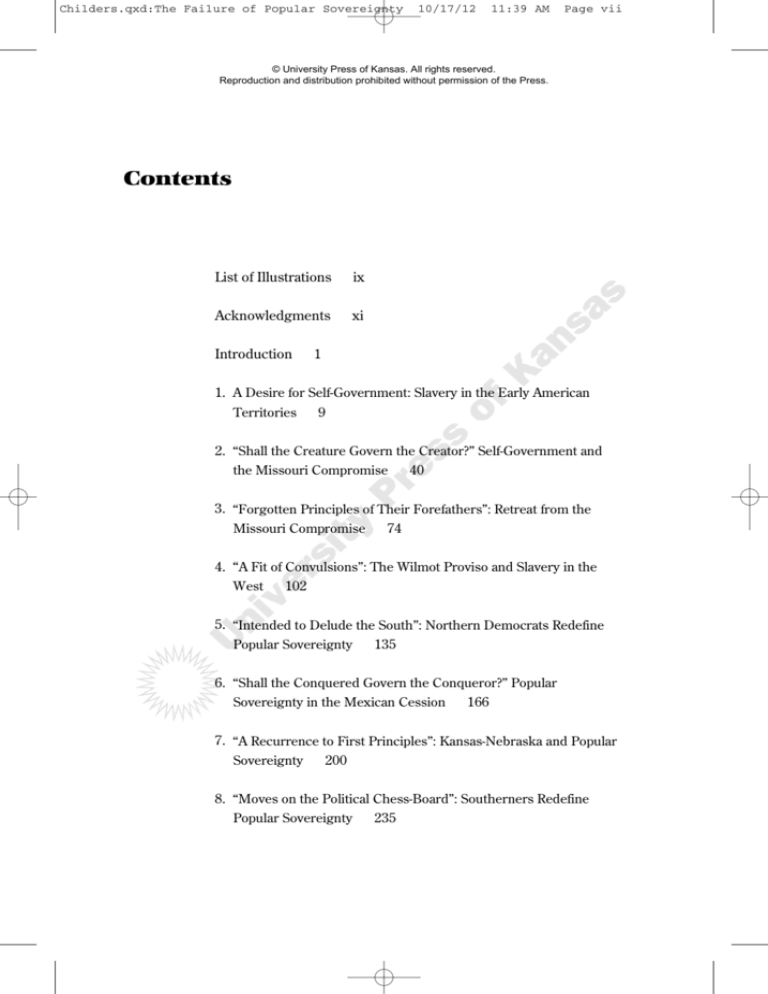
Childers.qxd:The Failure of Popular Sovereignty
10/17/12
11:39 AM
Page vii
© University Press of Kansas. All rights reserved.
Reproduction and distribution prohibited without permission of the Press.
Contents
List of Illustrations
ix
Acknowledgments
xi
Introduction
1
1. A Desire for Self-Government: Slavery in the Early American
9
Territories
2. “Shall the Creature Govern the Creator?” Self-Government and
40
the Missouri Compromise
3. “Forgotten Principles of Their Forefathers”: Retreat from the
74
Missouri Compromise
4. “A Fit of Convulsions”: The Wilmot Proviso and Slavery in the
102
West
5. “Intended to Delude the South”: Northern Democrats Redefine
135
Popular Sovereignty
6. “Shall the Conquered Govern the Conqueror?” Popular
166
Sovereignty in the Mexican Cession
7. “A Recurrence to First Principles”: Kansas-Nebraska and Popular
200
Sovereignty
8. “Moves on the Political Chess-Board”: Southerners Redefine
235
Popular Sovereignty
Childers.qxd:The Failure of Popular Sovereignty
7/10/12
1:01 PM
Page viii
© University Press of Kansas. All rights reserved.
Reproduction and distribution prohibited without permission of the Press.
viii
CONTENTS
Epilogue: The Demise of Popular Sovereignty and the Crisis of the
Union
Notes
269
283
Bibliography
Index
329
317
Childers.qxd:The Failure of Popular Sovereignty
8/10/12
12:03 PM
© University Press of Kansas. All rights reserved.
Reproduction and distribution prohibited without permission of the Press.
Illustrations
Maps
The United States, 1783–1803
The Missouri Compromise, 1820
The Compromise of 1850
24
70
197
The Kansas-Nebraska Act, 1854
231
Photographs and Drawings
Henry Clay
48
89
John C. Calhoun
George M. Dallas, Daniel S. Dickinson, and Lewis Cass
Lewis Cass and Thomas Ritchie
Zachary Taylor
143
170
Stephen A. Douglas
206
James M. Mason and Robert M. T. Hunter
Roger B. Taney
252
William Lowndes Yancey
275
209
130
Page ix
Childers.qxd:The Failure of Popular Sovereignty
7/10/12
1:01 PM
© University Press of Kansas. All rights reserved.
Reproduction and distribution prohibited without permission of the Press.
Page x
Childers.qxd:The Failure of Popular Sovereignty
7/10/12
1:01 PM
Page xi
© University Press of Kansas. All rights reserved.
Reproduction and distribution prohibited without permission of the Press.
Acknowledgments
Writing history has its moments of solitude, but in truth it is a
collaborative effort. Throughout my experience writing this book, I have benefited from the aid and advice of fellow scholars whose help has made my work
possible. Numerous archivists aided me in the search for sources. The staff at
the Southern Historical Collection at the University of North Carolina at Chapel
Hill aided me in the search for the letters and writings of southern leaders and
common people alike. The incredibly accommodating staff of the Duke University Libraries provided access to one of the premier collections of southern political papers, while visits to the Historical Society of Pennsylvania, the Newberry Library in Chicago, and the Joseph Regenstein Library at the University
of Chicago allowed me to search the papers of northerners involved in the making of popular sovereignty. Finally, I reserve special gratitude for Brian Leigh
Dunnigan, Barbara DeWolfe, and the staff at the William L. Clements Library at
the University of Michigan. A Jacob M. Price Visiting Research Fellowship from
the Clements Library allowed me to read the Lewis Cass Papers as well as other
key manuscript collections.
Numerous friends, colleagues, and mentors read and commented on drafts
of the manuscript. Gaines M. Foster, Paul Paskoff, Andrew Burstein, and
Charles Royster offered numerous suggestions on how to improve my work—
and continue to offer encouragement and support. Several friends read various
parts of the manuscript. Rachel Shelden read the manuscript and provided a
number of insightful comments that challenged me to consider the broader implications of my research. Kris Lawson commented on the chapters concerning
the Missouri controversy and offered advice on how to sharpen my analysis. I
owe a special debt to Adam Pratt, who reviewed two iterations of the project.
Adam and his wife, Jennifer, the closest of friends from our days in graduate
school at Louisiana State University, offered encouragement and friendship as I
wrote and rewrote chapters. Through his comments and in dozens of conversations, Adam always encouraged me to realize the full potential and consider the
full implications of my research. He is the greatest of friends and colleagues.
Childers.qxd:The Failure of Popular Sovereignty
7/10/12
1:01 PM
Page xii
© University Press of Kansas. All rights reserved.
Reproduction and distribution prohibited without permission of the Press.
xii
ACKNOWLEDGMENTS
At the University Press of Kansas, I found a generous supporter of my book
in Fred M. Woodward. His guidance through the steps of converting manuscript to book and his patience with a first-time author exemplify the very best
qualities of an editor. Just as importantly, Fred selected two outside reviewers
who likewise shared their time and advice charitably. Nicole Etcheson’s comments on two drafts of the manuscript proved invaluable in my efforts to write a
clear, coherent narrative. Most significantly, she challenged me to push the
boundaries of traditional political history by exploring the broader meaning of
the struggle over slavery in the West. Michael A. Morrison provided extensive
comments on the entire manuscript and offered his expert editorial advice. During an unforgettable four-week National Endowment for the Humanities seminar in Philadelphia, Mike shared his thoughts and his wisdom on how to realize
the full potential of my research. But his contribution extends beyond the work
of an editor; indeed, his guidance taught me much about how to write an effective book. Mike’s advice and comments helped this author, who was too close to
his subject, to recast the manuscript and make a stronger argument.
I owe my greatest professional debt to my mentor, William J. Cooper, Jr.
Truly a scholar and a gentleman, Bill taught me the historian’s craft—not only
in the classroom but also at the desk as we read through drafts of my dissertation—by the high example he sets as a careful researcher, a thoughtful wordsmith, and an unfailingly decent person. During my years in graduate school,
he provided research funds that allowed me to pursue an ambitious research
agenda that took me to the numerous archives mentioned above. I came to Baton Rouge seeking an advisor; I left having found a mentor and friend. I only
hope I can live up to the impeccable standard he sets.
Family has sustained me in my work. My parents and sister always supported my choice to pursue a career in what really is my hobby, sharing in the
highs and lows of my work and unfailingly cheering me onward. My father did
not live to see the book in print, but his presence remains in the heart and mind
of its author. Finally, the dedication is merely a token of appreciation for a
woman who has added an inestimable measure of meaning and happiness to my
life.
Though this book has benefited immensely from the aid and assistance of
colleagues, friends, and family, this is my work and I accept full responsibility
for it.
Childers.qxd:The Failure of Popular Sovereignty
7/10/12
1:01 PM
© University Press of Kansas. All rights reserved.
Reproduction and distribution prohibited without permission of the Press.
THE FAILURE OF
POPUL AR S OVEREIGNTY
Page xiii
Childers.qxd:The Failure of Popular Sovereignty
7/10/12
1:01 PM
© University Press of Kansas. All rights reserved.
Reproduction and distribution prohibited without permission of the Press.
Page xiv
Childers.qxd:The Failure of Popular Sovereignty
7/10/12
1:01 PM
Page 1
© University Press of Kansas. All rights reserved.
Reproduction and distribution prohibited without permission of the Press.
Introduction
In the eighty-five years between 1776 and 1861, the United States
of America had grown into a prosperous nation of thirty-four states linked by
economic prowess, common heritage, and an abiding, if still developing, sense
of nationalism. Yet with growth and prosperity came discontent as the nation’s
breathless pace of expansion sparked a furious debate over the institution of
slavery. Would the slave domain expand with the nation’s boundaries or would
the institution remain fixed in space? Over the course of the early nineteenth
century, slavery indeed became the South’s peculiar institution. Slavery, both a
labor system and a social system, brought great prosperity to the southern
states—and indirectly to the North as well. But a rising tide of moral indignation
against American slavery built within the northern states, leading to bitter recriminations between Americans North and South over the future of the institution. Northerners came to demand the prohibition of slavery in the nation’s vast
territorial domain, while southerners insisted on their right to take slaves into
any territory over which flew the Stars and Stripes.
The idea of territorial self-government, or what became known as popular
sovereignty, played a critical role in almost every debate over slavery in the territories between the creation of the republic and the onset of the Civil War.
From the formation of the Northwest Territory in the 1780s to the admission of
Kansas as a free state in 1861, politicians contested whether the power to prohibit slavery rested with Congress or the people residing in the territories. As
long as the United States had added territory to its national domain, leaders had
discussed whether decisions regarding the expansion of slavery should rest
with the federal government, as owner and agent for the territories themselves,
or with those who inhabited and who would inhabit them.
Scholars have traditionally dismissed the popular sovereignty doctrine as a
supple political contrivance devoid of substantive meaning. My book seeks to
restore some of its meaning by analyzing how its definition and application—
from the Confederation period to the coming of the Civil War—became enmeshed with the politics of slavery in the South. At its core, the dispute over
Childers.qxd:The Failure of Popular Sovereignty
7/10/12
1:01 PM
Page 2
© University Press of Kansas. All rights reserved.
Reproduction and distribution prohibited without permission of the Press.
2
INTRODUCTION
slavery in the territories paralleled the growing rift in American politics between northern nationalism and southern states’ rights advocates. In turn,
southern politics became defined by twin commitments to states’ rights and
slavery. At the same time, my study explains how the slavery debate radicalized
southern politics. Popular sovereignty, instead of quieting sectional passions
over the extension of slavery, actually gave voice to an increasingly radical,
states’ rights interpretation of the federal compact that placed slavery front and
center in the national political discourse.
Different interpretations of the nature of the Union prevailed between the
sections; northerners believed that the people themselves had created the Constitution, while southerners insisted that the states had created the federal government as their common agent, leaving the states with ultimate authority. Yet
practically since the founding of the republic, Congress had prohibited slavery
in the territories of the North while allowing the southern territories to determine the status of slavery for themselves. Of course, southerners had always established slavery in the founding charters of new states. In other words, territorial self-government had always resulted in the expansion of slave territory. A
majority of northerners and southerners alike seemed reasonably content with
an arrangement that basically divided the national domain into free and slave
territory.
The watershed debate over admitting Missouri into the Union, however,
shattered the notion of sectional comity over the slavery question that had prevailed with minimal challenge for some forty years. New York representative
James Tallmadge’s bid to prohibit slavery in Missouri as a condition of statehood transformed the slavery debate and southern politics by affirming federal
power over slavery in the territories. Southerners, fearful of any threat to the institution, joined westerners in vehemently asserting the right of local determination over the issue, while congressmen from the Northeast seemed more reticent to relinquish congressional authority, for they argued that Congress did
indeed possess the sovereign right to make the decision.1 Ultimately Congress
reaffirmed the idea of a dividing line between freedom and slavery. Slaves could
not pass into the Louisiana Purchase north of 36 degrees, 30 minutes latitude,
but to the south of the line citizens could permit or prohibit slavery as they
wished. But the Missouri controversy had revealed deep tensions between
North and South over the extension of slavery.
In its aftermath, an ever-growing group of southerners resolved to prevent
any further interference from northerners with slavery and its extension into
Childers.qxd:The Failure of Popular Sovereignty
7/10/12
1:01 PM
Page 3
© University Press of Kansas. All rights reserved.
Reproduction and distribution prohibited without permission of the Press.
INTRODUCTION
3
the territories. They did so by denying the right of regulation to the federal government. During the 1830s, the slavery debate reappeared with continued territorial expansion and the admission of new states to the Union, which occurred
against the backdrop of a growing abolition movement. In the congressional
gag rule debates of 1837 and 1838, John C. Calhoun emerged as the proponent
of an extreme states’ rights doctrine that sought to destroy the rising abolitionist vanguard and secure the future of slavery in the South—and the territories.
Once an ardent nationalist, the South Carolinian and his many allies became
convinced that federal authority would eventually become a weapon of the antislavery vanguard. With the zeal of a convert, Calhoun maneuvered to repudiate
the right of Congress to determine the status of slavery in the territories via a
curious mix of states’ rights and national power. To the Calhounites, popular
sovereignty in the territories permitted local control over the institution while
the Constitution trumped localism by dictating that slavery followed the flag
into the territories of the West. In the 1830s and 1840s, Calhoun had some difficulty convincing his fellow southerners of his theories; by the late 1850s, they
had virtually become political dogma in the South as extension became the
manifest destiny of the peculiar institution.
During the 1840s, however, northern Democrats appropriated the popular
sovereignty idea for themselves, transforming it into a doctrine that they hoped
would appeal to northern and southern Democrats alike, thereby saving their
political party and quieting discord over the extension of slavery. Instead, they
created a crisis over the meaning of popular sovereignty that further divided
North and South. Northerners like Senator Lewis Cass of Michigan and his
more prominent colleague, Stephen A. Douglas of Illinois, declared that the
people—at any time acting through their territorial legislatures—could permit
or prohibit slavery. Southerners insisted that territories became imbued with
sovereignty only when drafting a constitution and seeking admission to the
Union. In keeping with their states’ rights interpretation of the Constitution,
southerners believed, according to Don E. Fehrenbacher, “that the most legitimate embodiment of American sovereignty was a state convention drawn from
and acting for the people.”2 Did popular sovereignty rest in the masses or in the
states, acting on behalf of the people? This was the question that northerners
and southerners feuded over, just as they disagreed over states’ rights versus
nationalism. More than a mere question of constitutional theory, deciding how
popular sovereignty would work directly impacted whether the slave domain
would expand or not. Almost a decade of persistent discord over the meaning of
Childers.qxd:The Failure of Popular Sovereignty
8/10/12
12:04 PM
Page 4
© University Press of Kansas. All rights reserved.
Reproduction and distribution prohibited without permission of the Press.
4
INTRODUCTION
popular sovereignty destroyed the bisectional Democratic Party, removed the
South from the political mainstream of the Jeffersonian and Jacksonian eras,
and fostered the growth of a virulently radical form of southern politics designed to uphold states’ rights. By 1860, many southerners ironically called for a
massive expansion of federal power—via a federal slave code—to protect the
right of southern slaveholders to keep slaves in the territories.
My book explores the parallel relationship between the idea of popular sovereignty as applied to the extension of slavery and the nature of southern politics in the early American republic—both of which changed over time and in
concert with one another. As northerners grew increasingly hostile toward
slavery, southerners became increasingly defensive of the institution, their
way of life, and their role within the Union. The debate over what Douglas
would come to call popular sovereignty emerged in the earliest discussions of
whether to permit or prohibit the expansion of slavery into the national domain. Few historians have recognized the history of popular sovereignty before the 1840s; no scholar has yet portrayed its development as a process beginning with the first territorial acquisitions of the new nation to its
establishment as national policy in the 1850s, with passage of the Kansas-Nebraska Act and finally in the Supreme Court’s decision in Dred Scott v. Sandford, which imbued popular sovereignty with a pro-southern definition that mirrored Calhoun’s reasoning.3 By lending narrative coherence to the story of
slavery extension, my book bridges the work of historians who have traditionally examined the doctrine of popular sovereignty as proposed beginning in
the late 1840s and the recent writings of scholars who have focused more
closely on the struggles over slavery in the early republic.4 Historians such as
Michael A. Morrison have pointed to this approach in their works, suggesting
that a “sectionalization of the inherited revolutionary political heritage” transformed American politics in the twenty years preceding the Civil War.5 According to southerners, northerners saw society in the South as inferior and its peculiar institution as immoral. Just as colonists had chafed at imperial control
over local affairs, so slaveholders resented the efforts of antislavery politicians
to control the issue of slavery in the territories. Beginning in the late 1840s,
Democrats in the North and South “determined to remove this matter of local
concern from Congress and eliminate it from national political debate.”6 Their
efforts produced precisely the opposite outcome, as slavery subsumed all other
issues in national political discourse.
Yet the problem had existed long before the 1840s, and so too had the pro-
Childers.qxd:The Failure of Popular Sovereignty
8/10/12
12:04 PM
Page 5
© University Press of Kansas. All rights reserved.
Reproduction and distribution prohibited without permission of the Press.
INTRODUCTION
5
posed solution. Recovering the history of popular sovereignty from the nation’s
founding forward reveals how the expansion of slavery became the most contentious disagreement between North and South, a debate that in no small part
led to the coming of the Civil War. Congress implicitly established the principle
of popular sovereignty when it created the Southwest Territory in 1790. Slavery
was prohibited north of the Ohio River, but the people residing to the south
could determine the status of slavery for themselves. Of course, few believed
that the settlers would prohibit the institution, but territorial inhabitants desired, and in some cases demanded, a certain degree of political autonomy with
respect to the issue of slavery.
My work examines the concept of popular sovereignty by offering a narrative of how it surfaced and evolved during the era of the early American republic
and explaining how the debate over its meaning transformed and radicalized
southern politics, eventually marking a clear departure in practice and principle
from the established norms of American political discourse—which eventually
led the South outside the mainstream of Jeffersonian and Jacksonian politics.
Because neither North nor South could agree upon the meaning of popular sovereignty, it effectively “constitutionalized” the debate over slavery in the territories by mimicking the debate over the nature of the Union.7 The issue of when
or if a territory could ban slavery became a matter of constitutional interpretation, a process which culminated in the case of Dred Scott v. Sandford, when the
Supreme Court affirmed the southern interpretation of popular sovereignty.
Faced with the solemn vow of antislavery northerners to reject the high court’s
pronouncement, which they considered immoral and unjust, many southerners
began to believe that the federal government—acting as their common agent—
would have to take measures to protect slave property in the territories. The
idea of popular sovereignty, and indeed southern fealty to the American political
system and the Union, crumbled under the ever-increasing weight of cumbersome constitutional rhetoric over the slavery issue. A broader history of the
popular sovereignty idea shows how the debate over slavery transformed the
South into a rigid sectional bloc dedicated to the protection and perpetuation of
slavery, thereby providing essential insight into how and when the Union sundered.
Understanding popular sovereignty requires consulting sources from the
North and South, but my focus on southern politics reflects the fact that the
South was the fulcrum on which popular sovereignty operated. In almost every
context in which it came up, politicians offered the idea of local control over
Childers.qxd:The Failure of Popular Sovereignty
7/10/12
1:01 PM
Page 6
© University Press of Kansas. All rights reserved.
Reproduction and distribution prohibited without permission of the Press.
6
INTRODUCTION
slavery as a way to satisfy the South—or at least to compromise in a way that
would not offend the states’ rights constitutional scruples of southerners. For almost sixty years, popular sovereignty operated exclusively in the South; the
Northwest Ordinance and the Missouri Compromise prohibited the expansion
of slavery in the North. After 1847, northern Democrats used the doctrine as a
vehicle for compromise, seeking to unify their party across sectional lines by
proposing a solution acceptable to southerners. Popular sovereignty usually
emerged as a means to assure the people of the South that their voices would be
heard, that their concerns would be addressed. Its proponents sought to bridge
the Mason-Dixon Line, a division that seemed like a chasm during times like
the Missouri controversy, the introduction of the Wilmot Proviso, and the congressional debates of 1849 and 1850. Southern support for popular sovereignty,
which had emerged in the Missouri debates, became strongest in the late 1840s
and 1850s. Southerners rejected the doctrine, however, when northerners proposed a version of the doctrine that the South believed would halt the expansion
of slavery.
In order to chronicle accurately the evolution of the popular sovereignty
doctrine and to analyze its significance to the debates over slavery in the antebellum era, my book is organized as a narrative. It begins with an overview of
the debate over slavery in the territories from the implementation of the Northwest Ordinance to the time of the Missouri controversy. To understand how the
issue became so hotly contested in 1819 and 1820, one must investigate its origins in the first attempts to settle the vast national domain of the Old Northwest
and the Southwest regions of the United States. The second chapter addresses
southern attitudes toward territorial expansion and their legal formulations regarding the peculiar institution and its expansion, which developed during the
Missouri debates. Federal legislation beginning with the Northwest and Southwest Ordinances implicitly created a dividing line between slave and free territory. The Missouri Compromise expanded on this and firmly placed the concept of a division in American legal precedent. The subsequent chapter analyzes
this precedent in more detail by studying how specific territories became states
and how they exercised local control over the institution of slavery. I also discuss the congressional debate in 1837 and 1838 over the relationship between
the federal government and the territories, part of the larger debate over Senator Calhoun’s resolutions on the Union. Written in the midst of the well-known
“gag rule” debate, Calhoun’s resolutions touched on the right of Congress to determine the expansion of slavery in the territories. By addressing these basic le-
Childers.qxd:The Failure of Popular Sovereignty
7/10/12
1:01 PM
Page 7
© University Press of Kansas. All rights reserved.
Reproduction and distribution prohibited without permission of the Press.
INTRODUCTION
7
gal and political issues, this debate marked another step in the evolution of the
southern position on the meaning of popular sovereignty.
The acquisition of more territory from Mexico in 1848 led to the recrudescence of the issue of slavery in the territories in its most disruptive form since
the days of the Missouri Compromise. Chapters 4 and 5 analyze the effort to settle this increasingly fractious dispute, as northern Democratic leaders like
George M. Dallas of Pennsylvania, Daniel S. Dickinson of New York, and Lewis
Cass of Michigan reformulated and articulated the concept of popular sovereignty. The doctrine remained in the national spotlight for the succeeding
twelve years; the debate over its application would also continue unabated. The
Compromise of 1850 and its settlement for the Utah and New Mexico territories, as explained in chapter 6, put popular sovereignty into practice. But the debate over the compromise measures and the settlement for the territories provoked contention over the idea of popular sovereignty itself. When in 1847 the
northern Democrats proposed applying the doctrine to the Mexican Cession,
many moderate southerners enthusiastically accepted it as a suitable compromise. Some proponents of the doctrine, most notably Dickinson, explicitly
stated that the citizens of a territory had the right to decide on the slavery issue
before applying for statehood and crafting a constitution. In his seminal formulation of popular sovereignty, Cass left this question unanswered, most likely in
a purposeful effort to appease people on both sides of the Mason-Dixon Line.
Southerners bristled at the idea of allowing the pivotal decision on the future
of slavery to be made before the population of a territory had fully developed.
Radical southerners who identified with the politics and theories of John C. Calhoun threatened solid southern support for what the Calhounites derisively
called “squatter sovereignty.” Whigs and Calhounites in the South helped ensure Cass’s defeat in 1848 and raised critical questions about just how his version of popular sovereignty would work—questions that Cass himself declined
to answer. These issues had particular significance in the case of New Mexico,
where southerners accused Mexicans of manipulating the political process in
an effort to bar the introduction of slavery. Slave-state leaders argued that this
course allowed the conquered to govern the conqueror. The admission of California as a free state and the creation of New Mexico Territory with an openly
antislavery government threatened southerners, who withdrew support for popular sovereignty in this form—and for Cass, whom they saw as deceptive.
Sectionalism actually grew before the fiasco in Kansas Territory and the
southern rights question became more, not less, salient six years before Lin-
Childers.qxd:The Failure of Popular Sovereignty
7/10/12
1:01 PM
Page 8
© University Press of Kansas. All rights reserved.
Reproduction and distribution prohibited without permission of the Press.
8
INTRODUCTION
coln’s election. As explained in chapter 7, passage of the Kansas-Nebraska Act
in 1854 only widened the sectional chasm by reinforcing southern unity across
party lines at a time when the northern Democracy had begun to disintegrate. A
pet project of Stephen A. Douglas, Nebraska seemed beyond debate regarding
the slavery issue, as it lay north of the compromise line of 1820. Southerners,
however, pushed Douglas to divide the vast region into two territories—Kansas
and Nebraska—and to include an explicit repeal of the Missouri Compromise
line. The Illinoisan obliged, arguing that the Compromise of 1850 had rendered
it “inoperative” anyway. Popular sovereignty would replace the line that had become odious to many southerners, a consideration that played no small part in
moving many southerners to reconsider the doctrine they jettisoned following
the 1850 debate. Chapter 8 explains why popular sovereignty enjoyed greater
support from the southern states in 1854 than ever before, but also how that
support eroded with the reappearance of the old debate over when a territory’s
settlers could exercise their popular sovereignty, which would prove its ultimate undoing. The proponents of popular sovereignty looked to the Supreme
Court for a final determination on how the doctrine would operate in practice.
Southerners rejected Douglas’s interpretation of popular sovereignty and
heaped scorn upon its chief proponent, who they believed had defined the doctrine against their best interests. When the Supreme Court endorsed the southern version of popular sovereignty in the Dred Scott case, many northerners
spurned the Court itself and refused to abide by its determination. Faced with
the Pyrrhic victory in the Supreme Court, slave-state politicians identified but
one remaining course of action: eschew the popular sovereignty doctrine and
demand federal protection of slavery in the territories. The epilogue evaluates
how popular sovereignty failed and even played a role in the destruction of the
Union because neither North nor South could agree on its meaning. The debate
between states’ rights and nationalism subsumed the popular sovereignty discourse, destroying the series of moderate stances on slavery that politicians had
embraced in one form or another for eighty-five years.


